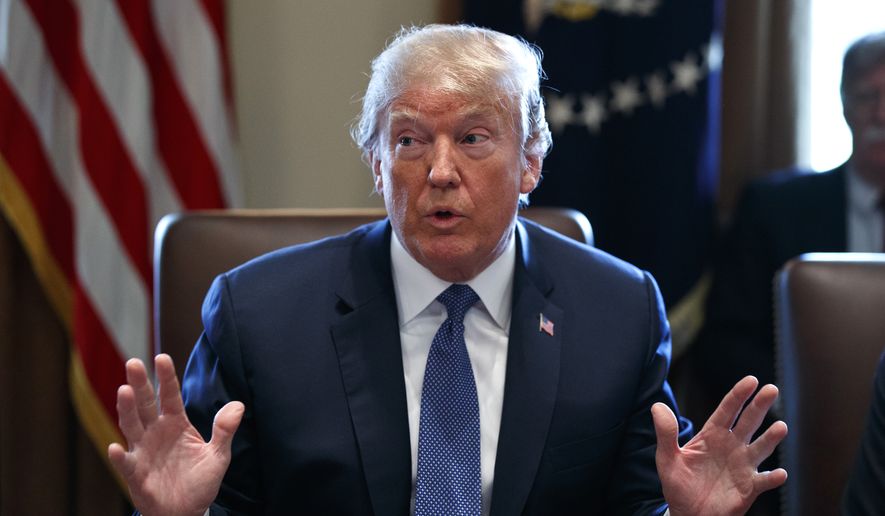Republicans’ tax cuts and the new spending bill Congress approved last month will send the economy surging this year to 3.3 percent growth — but will also send the deficit soaring back to the record levels of the early Obama years, the Congressional Budget Office said Monday.
Deficits will top $800 billion this year and will reach $1 trillion by 2020, just as President Trump prepares to face voters in his bid for re-election. They will remain above $1 trillion for the foreseeable future, the analysts said, painting a better economic picture but a significantly worse fiscal picture than last year.
Those deficits will quickly build, doubling the government’s main pool of debt over the next decade. Debt held by the public will stand at a staggering $29 trillion by 2028, the analysis said, prompting a warning from CBO Director Keith Hall.
“Nobody knows what’s too much debt — what will cause a fiscal crisis,” he said, detailing the grim news. “The bigger the debt, the bigger the chances of a fiscal crisis.”
Republicans, who powered through massive tax cuts and then cut a deal with Democrats to surge spending, were mostly silent on the numbers. But House Republicans scheduled a vote later this week on adding a balanced budget amendment to the Constitution, which could force some fiscal restraint.
It could also, however, force deep cuts to Social Security, Medicare and the other big entitlement spending programs that are driving the long-term budget imbalance.
Democrats accused Republicans of agitating for just that outcome, saying the tax cuts were designed to starve the government of money to pave the way for those cuts.
“That is unacceptable,” said Sen. Bernard Sanders, the Vermont independent who serves as the Democrats’ top lawmaker on the Senate Budget Committee. “At a time of massive wealth and income inequality, we have got to repeal all of President Trump’s tax breaks for the wealthy and big corporations and rebuild the disappearing middle class.”
The CBO report said the tax cuts will give a serious boost to the economy in the near term. Real growth in gross domestic product, which last year was projected to be 2 percent in 2018, will now reach 3.3 percent. Next year’s growth will rise from 1.5 percent to 2.4 percent.
Perhaps even more striking is the employment picture, where the economy is going gangbusters.
It will add some 3 million more jobs in 2018 and 2019 than the CBO predicted in its last report, which will send the jobless rate even lower. It will average 3.8 percent this year and dip to 3.3 percent next year — the lowest figure in the post-World War II era.
The CBO said the tax cuts and the additional spending will boost consumer demand, supercharging the economy.
But rising interest rates will soon sap some of that surge, the analysts said. By 2020 — just as Mr. Trump is facing voters for re-election — GDP growth will have slipped back below 2 percent.
The short-term boost also comes at a significant price: The government will run a deficit of $804 billion this year, which is much bigger than last year’s $665 billion tally. But for shifts in timing of payments, the deficit would have been even worse, at $848 billion, which would have been a one-year surge of 28 percent.
The deficit will be $1 trillion by 2020 and $1.3 trillion a year by 2025. That is when some of the new tax cuts are slated to expire, which would stabilize deficits at that level. But if Mr. Trump gets his way and Congress makes the tax cuts permanent, then the fiscal picture could be even worse.
Under that scenario, deficits could reach $2 trillion a year within a decade, watchdogs said.
As it is now, things are looking bad enough.
The biggest drivers of the problem are interest payments on the debt and the entitlement programs that make up the social safety net.
The government is slated to spend $4.1 trillion this year: $2.5 trillion of that on entitlements, $1.3 trillion on defense and domestic discretionary spending such as education and the environment, and $316 billion on interest payments on the debt.
By 2028, the government will spend $7 trillion: $4.5 trillion of that on entitlements, $1.6 trillion on defense and domestic discretionary programs, and a staggering $915 billion on interest payments.
The government will borrow 19 cents of every dollar it spends this year. By 2020, when Mr. Trump is up for re-election, that will be 22 cents.
“No one can say they didn’t see this coming. Analysts have said for years that a debt problem was looming on the horizon,” said Shai Akabas, economic policy director at the Bipartisan Policy Center. “Now that it’s upon us, those who have their heads buried in the sand are in for a rude awakening.”
But the Center on Budget and Policy Priorities, a liberal-leaning think tank, said the numbers weren’t as bad as they might seem. All it will take are sizable tax increases.
“The budget outlook is no reason for alarm,” wrote Paul N. Van de Water, senior fellow at CBPP.
He also warned against the Republicans’ push for a balanced budget amendment to the Constitution, saying it would tie policymakers’ hands during economic downturns, preventing them from injecting any spending stimulus.
• Stephen Dinan can be reached at sdinan@washingtontimes.com.




Please read our comment policy before commenting.